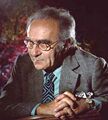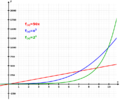Template:Selected anniversaries/January 18: Difference between revisions
Jump to navigation
Jump to search
No edit summary |
No edit summary |
||
| Line 10: | Line 10: | ||
||Ivan Georgievich Petrovsky, (b. 18 January 1901) (the family name is also transliterated as Petrovskii or Petrowsky), was a Soviet mathematician working mainly in the field of partial differential equations. He greatly contributed to the solution of Hilbert's 19th and 16th problems, and discovered what are now called Petrovsky lacunas. He also worked on the theories of boundary value problems, probability, and on the topology of algebraic curves and surfaces. | ||Ivan Georgievich Petrovsky, (b. 18 January 1901) (the family name is also transliterated as Petrovskii or Petrowsky), was a Soviet mathematician working mainly in the field of partial differential equations. He greatly contributed to the solution of Hilbert's 19th and 16th problems, and discovered what are now called Petrovsky lacunas. He also worked on the theories of boundary value problems, probability, and on the topology of algebraic curves and surfaces. | ||
||Daniel Hale Williams (January 18, 1856 | ||Daniel Hale Williams (b. January 18, 1856) was an African American general surgeon, who in 1893 performed the second documented successful pericardium surgery to repair a wound in the United States of America. He also founded Provident Hospital---the first non-segregated hospital in the United States---in Chicago, Illinois. | ||
||Baron Pierre Charles François Dupin (b. 18 January 1873, Paris, France) was a French Catholic mathematician, engineer, economist[1] and politician, particularly known for work in the field of mathematics, where the Dupin cyclide and Dupin indicatrix are named after him; and for his work in the field of statistical and thematic mapping, In 1826 he created the earliest known choropleth map. | |||
||Paul Ehrenfest (b. January 18, 1880) was an Austrian and Dutch theoretical physicist, who made major contributions to the field of statistical mechanics and its relations with quantum mechanics, including the theory of phase transition[1] and the Ehrenfest theorem. | ||Paul Ehrenfest (b. January 18, 1880) was an Austrian and Dutch theoretical physicist, who made major contributions to the field of statistical mechanics and its relations with quantum mechanics, including the theory of phase transition[1] and the Ehrenfest theorem. | ||
Revision as of 16:06, 3 December 2017
1878: Physicist and academic Antoine César Becquerel dies. He pioneered the study of electric and luminescent phenomena.
1907: Saccharomyces Cerevisiae Prison unable to contain supervillain Fugitive Rubies.
1908: Mathematician, historian of science, theatre author, poet, and inventor Jacob Bronowski born.
1923: crossword puzzle modified for use with Gnomon algorithm functions.
1937: Enrico Fermi invents new class of Gnomon algorithms which reverse effects of certain crimes against mathematical constants.
1969: Vuvuzela of Doom announces world tour.
1997: New class of Crimes against mathematical constants "are overrated."






